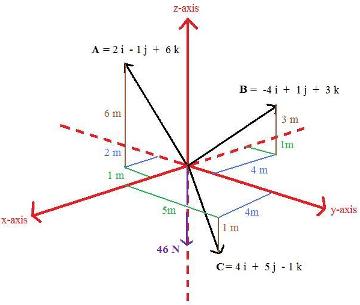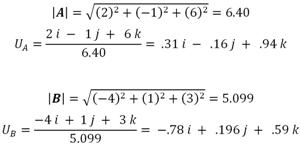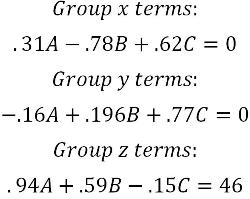LESSON 3: 3D Sum Of Forces
Letís say you are given a three dimensional problem where there are three ropes with unknown tensions holding up a weight (this is a standard type of problem). The first step in this alternate method is to

The graph to the right shows three vectors (vectors A, B, and C), whose lengths are given but forces are unknown, holding up a 46 N force (purple vector). To find the force in each vector first find the length of each vectorís component parts. For example, vector A goes 2 m in the x-direction, 1 m in the negative y-direction, and 6 m in the z-direction, so the length vector for vector A looks like this: 2 i - 1 j + 6 k . Next, find each vectorís unit vector:


After finding each unit vector, then multiply each unit vector by its respective vectorís unknown force:

Now we can set up three equations with three unknown variables. Group the x-components together, y-components together, and z-components together to set up the three equations:


Tutorial Options:
Return to Home Page
Statics Lessons Home Page
Statics Example Problems
Continue to Next Section
Return to Home Page
Statics Lessons Home Page
Statics Example Problems
Continue to Next Section
Lesson 1:
Vectors
Magnitude
Unit Vectors
Cos Angles
Lesson 2:
Sum of Forces
Sum of Forces 2
Lesson 3:
3D Sum of Forces
Lesson 4:
Moments
Moments 2
Lesson 5:
Trusses
Method of Joints
Method of Sections
Lesson 6:
Distributed Load
Vectors
Magnitude
Unit Vectors
Cos Angles
Lesson 2:
Sum of Forces
Sum of Forces 2
Lesson 3:
3D Sum of Forces
Lesson 4:
Moments
Moments 2
Lesson 5:
Trusses
Method of Joints
Method of Sections
Lesson 6:
Distributed Load